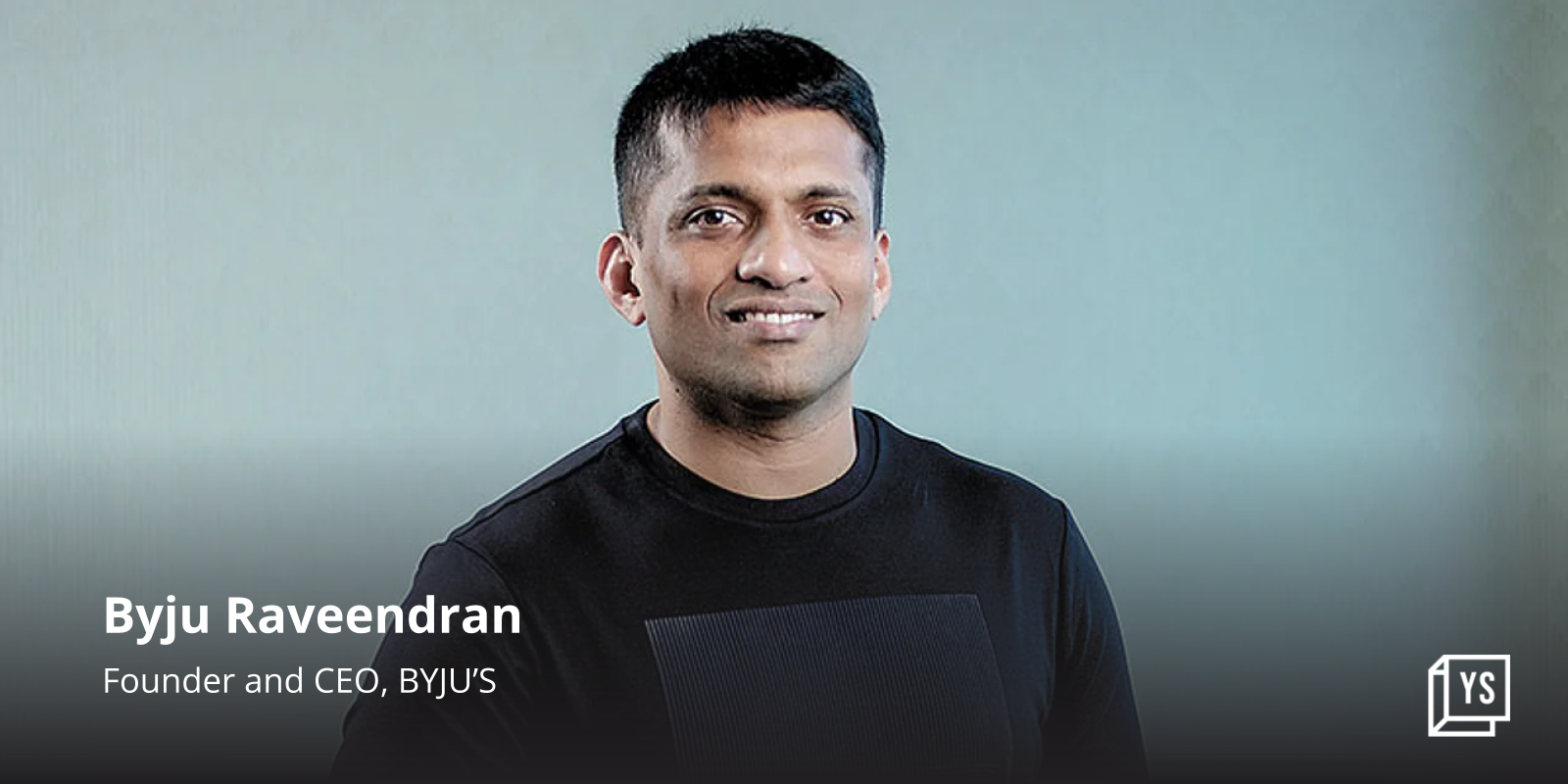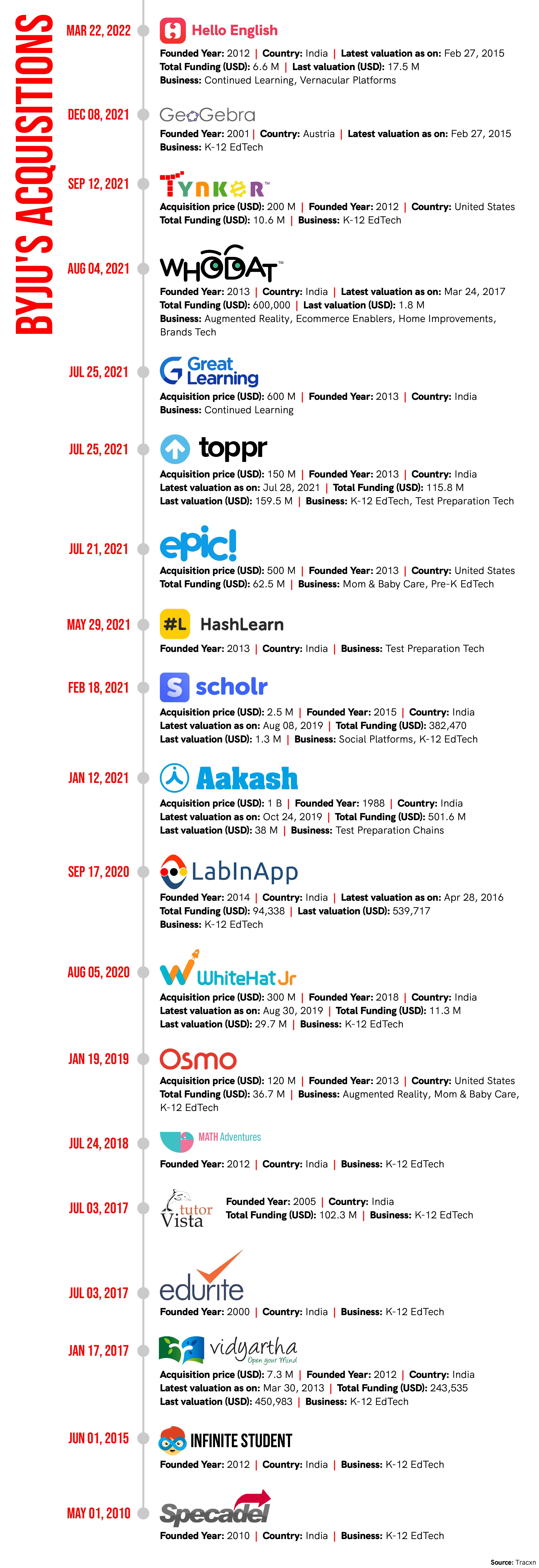
This is a moment of introspection for BYJU’S. Given the fires that the edtech startup has had to put out in the past year, it needs to focus on its core online offerings and lose ventures that have become dead weight.
Industry experts say that the Bengaluru-based startup should adopt a long-term strategy rather than relying on short-term remedies. It needs to emphasise on identifying and prioritising its core business through the effective use of technology.
The Byju Raveendran-founded K-12 edtech platform began its journey in 2011 with a technology-driven approach to learning, offering a wide range of educational courses and content, including interactive apps and online materials. Its content spanned from kindergarten to higher education across various subjects and classes.
“BYJU’S was way ahead of a lot of edtech companies by bringing innovation on its platform using technology,” says a senior education industry leader, adding that the company has strong product and technology understanding.
In edtech, the inevitable future revolves around customising and personalising learning with minimal human intervention, notes a venture capitalist (VC) with edtech investments.
“BYJU’S was in a unique position to drive this disruption, but currently, it must first undo lots of things before moving forward,” he adds.
Core business
BYJU’S’ core online business has shown progression over the years, however, it “isn’t growing” at a rate expected for a company of its size and scale, which makes the path forward “not an easy one”, remarks an executive at a major edtech company.
In FY21, BYJU’S reported a decline in revenue, attributing it to a change in revenue recognition method and suggesting that FY22 would witness a significant improvement in numbers due to accrued revenue.
The available data for FY22 reveals that the company’s total income from its core business rose by 130% to Rs 3,569 crore. Notably, BYJU’S had stated that it had achieved revenue of nearly Rs 10,000 crore in FY22.
BYJU’S EBITDA loss for the core business decreased to Rs 2,253 crore in FY22, down 6% from Rs 2,406 crore in the previous financial year, as per a company statement. EBITDA (earnings before interest, taxes, depreciation and amortisation) is a measure of core operational efficiency.
The company has not disclosed the net loss from its core business, as well as consolidated revenue and profit/loss figures for FY22.
One of the reasons behind the edtech firm’s losses is its Customer Acquisition Cost (CAC) challenge, explains the edtech executive quoted above, adding that as long as a solution for the CAC issue remains elusive, these losses are expected to persist.
While its core business lies in online education, BYJU’S has become one of India’s first edtech startups to venture into offline tutoring—the results of which have been lacking.
In 2022, the company unveiled plans to set up 500 centres across India, outlining an investment of $200 million over 12-18 months. By October 2022, over 200 centres were confirmed to be in operation. This number increased to over 300 by early this year.
However, experts note that the expansion of tuition centres has paused due to lower-than-expected business generation and higher operational costs.
“Offline is historically a low-margin business. Seasoned brands like ALLEN, Aakash, Sri Chaitanya and Narayana also haven’t been able to achieve profit margins of more than 15-20% in this market,” the edtech executive shares.
He elaborates that for a new company engaged in substantial CAPEX investment and acquiring customers at a high cost, achieving breakeven becomes “very difficult”. He emphasises that, even after two years, this business model is unlikely to yield more than a 5-7% profit margin, and it “won’t solve BYJU’S problems”.
For online-first companies, offline isn’t an easy play as it calls for a large upfront capital and the wait for profit to trickle. Moreover, the unit economics between offline and online differ.
“BYJU’S should place a primary focus on its online business, as this aligns with its foundational strengths, and it’s imperative to assess the profitability of its offline ventures,” the senior education industry leader, quoted earlier, remarked.
.thumbnailWrapper
width:6.62rem !important;
.alsoReadTitleImage
min-width: 81px !important;
min-height: 81px !important;
.alsoReadMainTitleText
font-size: 14px !important;
line-height: 20px !important;
.alsoReadHeadText
font-size: 24px !important;
line-height: 20px !important;

So, what does this mean for BYJU’S offline business?
The edtech executive suggests that given BYJU’S prior CAPEX investments, the firm should “work hard” to attain breakeven in the offline business, as it holds the potential to generate revenue—that could help BYJU’S have a steady revenue momentum.
He elaborates that, among the 300-plus centres, BYJU’S should consider shutting the underperforming tuition centres or those located in non-serviceable pin codes, concentrating only on those that show promise.
Goodwill hunting
Experts say that the company should focus on organic customer acquisition as it is a cost-effective way to grow its customer base and ultimately lower its CAC. By creating a strong online presence, it can attract customers without the need for significant advertising spending.
Over the years, BYJU’S has heavily relied on marketing and advertising to acquire and retain customers.
<figure class="image embed" contenteditable="false" data-id="530604" data-url="https://images.yourstory.com/cs/2/d99b1110116911ed9e63f54395117598/ByjuAcquisitionTimeline-1699810339359.jpg" data-alt="Byju's timeline" data-caption="
Credit: Nihar Apte
” align=”center”> Credit: Nihar Apte
The startup consistently allocated a significant portion of its total expenses to advertisement and promotion costs. Financial records indicate these expenditures were Rs 8.63 crore (27.4%) in FY14. This figure jumped to Rs 71.18 crore (44.5%) in FY16. In FY21, the company spent a whopping Rs 2,250.94 crore (32%) on advertisement and promotion costs.
It’s important to note that the FY22 revenue figures (when it was Rs 10,000 crore) are from a period when BYJU’S enjoyed a strong brand presence, marked by sponsorships like the IPL and endorsements from Shah Rukh Khan.
If the core business performance remained at this level in FY22, experts foresee considerably lower figures for FY23 and FY24, given the negative public relations and other challenges the company has faced.
“BYJU’S should concentrate on regaining the goodwill of both students and their parents,” the senior education industry leader says, adding that students loved the way it taught.
While BYJU’S initial organic growth data is not widely documented, a look at the available revenue figures shows its steady rise.
According to BYJU’S financial documents, its revenue from operations was Rs 19.11 crore in FY14, Rs 44.48 crore in FY15, Rs 108.96 crore in FY16, Rs 230.20 crore in FY17, Rs 460.87 crore in FY18, and Rs 1,305.92 crore in FY19.
This data shows initial growth, with most of the revenue coming from the primary business.
The startup has lost the plot somewhere along the journey.
Today, BYJU’S’ popularity doesn’t seem to match its size and scale, with newer and smaller companies often attracting more attention, according to the founder of an edtech company, who believes the pricing of BYJU’S’ products is on the higher side.
Apart from pricing, BYJU’S sales practices have garnered bad press.
Allegations against the company include sales personnel making misleading pitches to the parents and persuading them into buying subscriptions beyond their means.
To replace its previous direct sales approach, BYJU’S introduced a 4-tier tech-driven internal sales process earlier this year.
The edtech executive believes that BYJU’S hasn’t yet devised an alternative to its push sales strategy, and without finding a solution, its margins will not see improvement—a shift from a push to pull business model is necessary.
Path to sustainable growth
Industry experts recommend that BYJU’S run the company with the same frugality as one would manage a startup (0-1 business).
The key steps that BYJU’S needs to take are rebuilding confidence among employees, customers, and investors, and reevaluating its overall business strategy by identifying areas it wants to focus on and those it wants to divest from, according to the VC quoted above.
BYJU’S has spent over $3.5 billion on 19 acquisitions, as per Tracxn. It has invested in multiple sectors such as K-12 (kindergarten to 12th grade), continued learning, test preparation tech, and more.
.thumbnailWrapper
width:6.62rem !important;
.alsoReadTitleImage
min-width: 81px !important;
min-height: 81px !important;
.alsoReadMainTitleText
font-size: 14px !important;
line-height: 20px !important;
.alsoReadHeadText
font-size: 24px !important;
line-height: 20px !important;

The startup is considering the sale of two of its assets, Epic, a digital reading platform for children, and the skilling startup Great Learning, both acquired in 2021 for $500 million and $600 million, respectively.
“BYJU’S has already undertaken significant cost restructuring but when so many acquisitions happen, a lot of added costs come to the table. The overall costs are still high, it should target a reduction of at least 50% across all verticals within a one-year timeframe,” the edtech executive says.
BYJU’S has said that Arjun Mohan, who was appointed as the India CEO in September a few months after he re-joined the firm, is in the final stages of a business restructuring.
The company is also expected to execute a workforce reduction of over 5,000 permanent and contractual employees as part of the restructuring effort.
From 2022 onward, job cuts at the company have already affected at least 5,000 individuals, as per media reports.
As part of its course correction, the firm appointed Mohandas Pai, former CFO and Board Member of Infosys, and Rajnish Kumar, former Chairperson of State Bank of India, to its advisory council in July.
Subsequently, Richard Lobo, former EVP and Head of Human Resources of Infosys, joined BYJU’S as an exclusive advisor to help transform the edtech’s HR function.
Numerous complexities, including challenges with lenders and the Aakash acquisition, could disrupt BYJU’S ability to operate the business with a clear focus, the edtech startup founder says.
In January 2021, BYJU’S acquired Aakash Educational Services Limited for a mammoth $1 billion, closing the world’s largest edtech acquisition by a venture capital-backed company.
However, recent reports have suggested the potential return of Aakash Chaudhry, co-promoter and co-founder of AESL, as the Chief Executive Officer, likely connected to the finalisation of a stock-swap agreement with BYJU’S parent company, Think and Learn Pvt Ltd, as part of AESL’s acquisition.
Last week, Ranjan Pai, Chairman of Manipal Education and Medical Group, purchased Rs 1,400 crore debt in Aakash. This financial step is aimed to assist BYJU’S in settling a Rs 2,000 crore ($250 million) debt from US-based lender Davidson Kempner Capital Management, which the edtech firm secured in May by using its Aakash shareholding as collateral. Pai also secured a seat on Aakash’s board as part of this financial transaction.
Aakash is BYJU’S’ cash cow, says the VC. “It’s a matter of trade-offs; if BYJU’S wants to preserve its other ventures, is it inclined to divest Aakash to inject cash into the system and refocus on its business? It’s a strategic discussion about determining what should constitute the core business going forward and what should be considered non-core,” he explains.
Industry insiders say that BYJU’S needs to take a step back, reassess its long-term strategy, streamline its operations, and concentrate on its core areas of expertise as it progresses, avoiding the temptation to do too many things.
Edited by Affirunisa Kankudti










